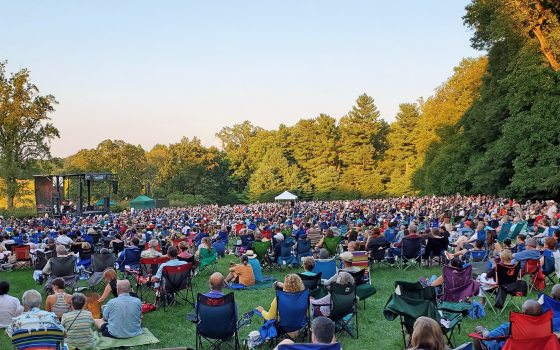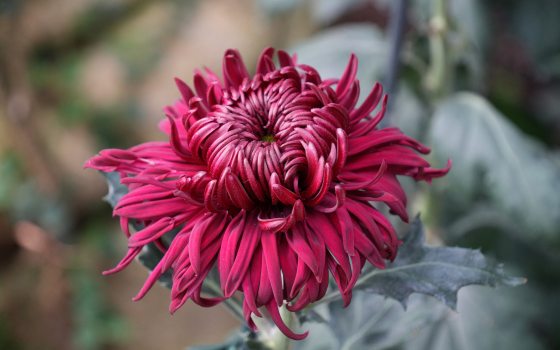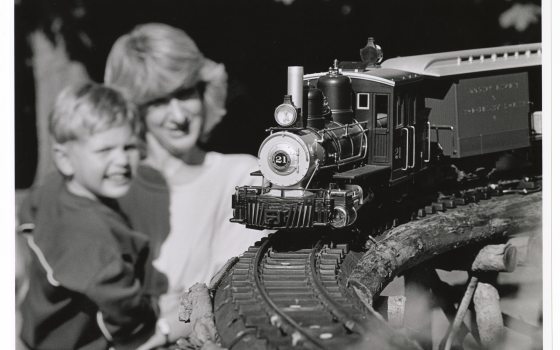Editor’s note: Written by Longwood P.S. du Pont Fellow Colvin Randall and organ historian, journalist, and consultant Jonathan Ambrosino, Garden of Music beautifully traces Longwood’s remarkable history of the performing arts. The book is available in The Garden Shop and online.
From the time my parents first brought me to Longwood for my 13th birthday, to my 1973 acceptance into the Longwood Graduate Program at the University of Delaware, to beginning my career with Longwood in 1977—over time managing public relations, overseeing performing arts, and leading the maintenance of Longwood’s musical instruments before becoming Longwood’s first P.S. du Pont Fellow in 2008—I’ve experienced a half-century of exploration and enjoyment here at Longwood. I’ve spoken across the country about Longwood, focusing on its history, the evolution of its landscape, and its legacy of performing arts and along the way I’ve written seven books about Longwood—including the just-released Garden of Music, a celebration of the performing arts at Longwood. For more than a century, music, dance, and theater have filled the Gardens with more than 10,000 events—and counting. No garden in American can equal such a performing arts legacy—and with Garden of Music I share the stories of Longwood’s performing arts legacy, in which over the years I have been—and continue to be—happily immersed.
With the publication of Garden of Music, I can now reflect upon what it took to assemble what might be considered the definitive book on the history of Longwood's performing arts from the time of founder Pierre du Pont to the present. Much is due to Mr. du Pont’s interest in the overall du Pont family story, of which he was a major player. Even before he assembled scattered archives to preserve the larger picture, he was saving his own papers in excruciating but wonderful detail, allowing the researcher to reconstruct a microscopic view of his and wife Alice’s daily life. This was pointed out to me in 1973 by the staff at the Hagley Museum and Library where the papers are preserved. I had just entered the Longwood Program in Ornamental Horticulture at the University of Delaware, and I chose the history of Longwood’s fountains as my thesis topic. It wasn’t long before I came across hundreds of documents that revealed a fascinating story of music, theater, dance, and other entertainment at Longwood. Fifty years later, it has finally been put down in print with Garden of Music.
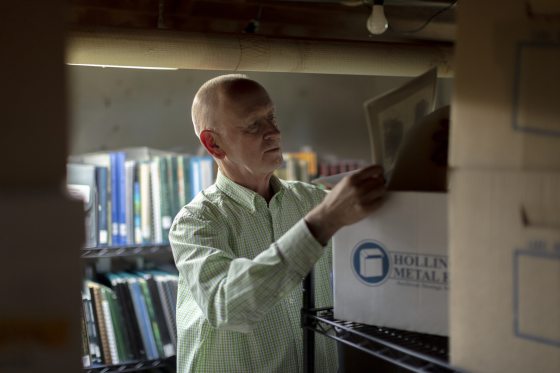
P.S. du Pont Fellow Colvin Randall, pictured in Longwood’s Archives. Photo by Daniel Traub.
Over the decades, I was fortunate to get to know those who were related to or had worked for Mr. du Pont, and who remembered bits and pieces of the puzzle that makes up the complete story. Pierre’s nephews W.W. “Chick” Laird, Jr., Irénée du Pont, Jr., and the Benarcik and Geesey families who were close to staff organist Firmin Swinnen are just a few who provided facts, anecdotes, and wonderful memories.
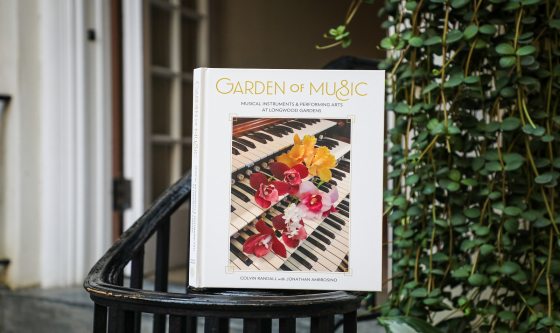
Garden of Music by Colvin Randall and Jonathan Ambrosino. Photo by Jen Fazekas.
There is also a technical side to the book, namely a discussion of complex pipe organs. I started playing the organ in ninth grade, culminating in three years of study at Washington National Cathedral while a student at the University of Virginia. When I started employment at Longwood in 1977, I was naturally drawn to the Longwood Organ. Upon staff organist Clarence Snyder’s retirement, I was asked to oversee the instrument and performing arts in addition to my duties as Publicity Coordinator.
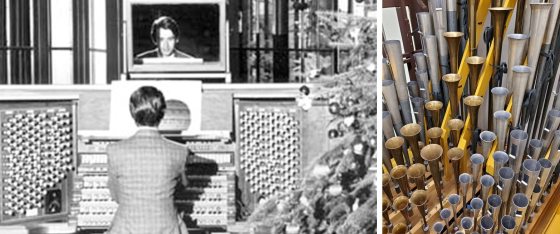
Colvin Randall plays holiday music in the Ballroom in 1978 (left photo); pipes in the Longwood Organ’s Fanfare Division. Right photo by Colvin Randall.
But playing the organ and caring for it are two different worlds, so we were fortunate to have had skilled technicians who kept it running and ultimately restored it to mint condition. One of those was Jonathan Ambrosino, who co-authored Garden of Music. His insight has been crucial to telling the full story.
The book starts with a detailed discussion of Pierre du Pont’s early exposure to music and theater. His letters home while enrolled at MIT often focused on music, his piano playing, and theater attendance. Then he started acquiring keyboard instruments, building a theater (today known as The Playhouse on Rodney Square), and underwriting performing arts and musicians. Performing arts became the main social activity at Longwood, where he and Alice entertained as well as provided a beautiful setting for charity events.
Longwood’s fabled Garden Parties, the Savoy Company’s and Brandywiners’ more than 600 performances, the forgotten American Legion Pageants, and the Marine Band and John Philip Sousa concerts are all included. Longwood has had two pipe organs, the first eventually donated to the University of Delaware and its replacement still filling Longwood’s Ballroom with impressive sound. Both instruments are analyzed in detail, including the recent restoration. The book also covers Longwood’s pianos and its 62-bell carillon whose casting in The Netherlands is shown in step-by-step photos.
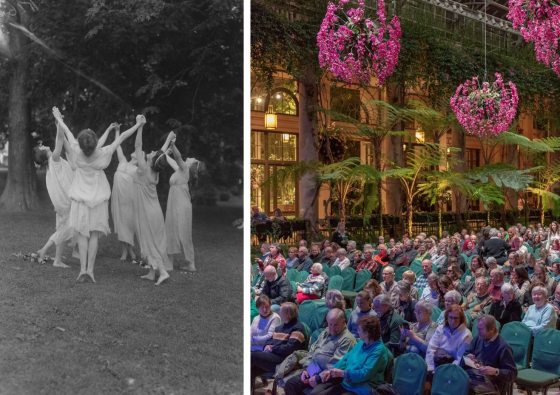
Entertainment at the 1915 Garden Party (left photo); the audience awaiting an Exhibition Hall concert in 2019 (right photo). Left photo by Frances Benjamin Johnston; right photo by Daniel Traub.
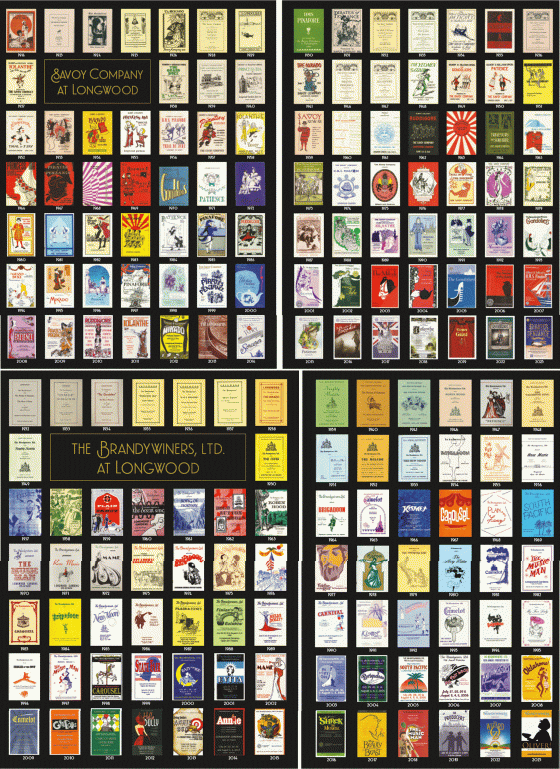
The Savoy Company Longwood program covers 1916-2023 (top photos); The Brandywiners Longwood program covers 1932-2023 (bottom photos).
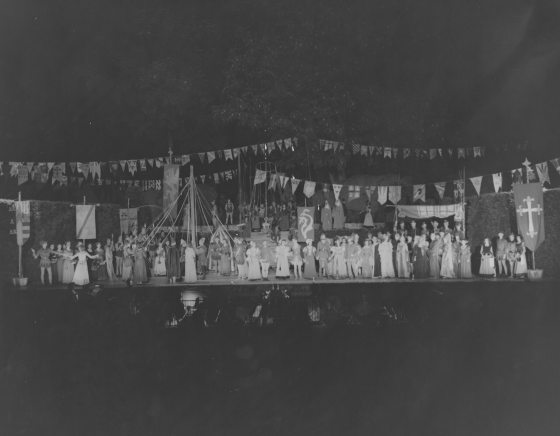
The Brandywiners’ production of Robin Hood in 1946.
The star performer during Pierre’s time was organist Firmin Swinnen. All his scrapbooks and memorabilia have been saved and permit a thorough reconstruction of his amazing career. Likewise, the story of his successor, Clarence Snyder, is told for the first time. Also presented are key staff, forgotten until now, who realized Mr. du Pont’s dreams.
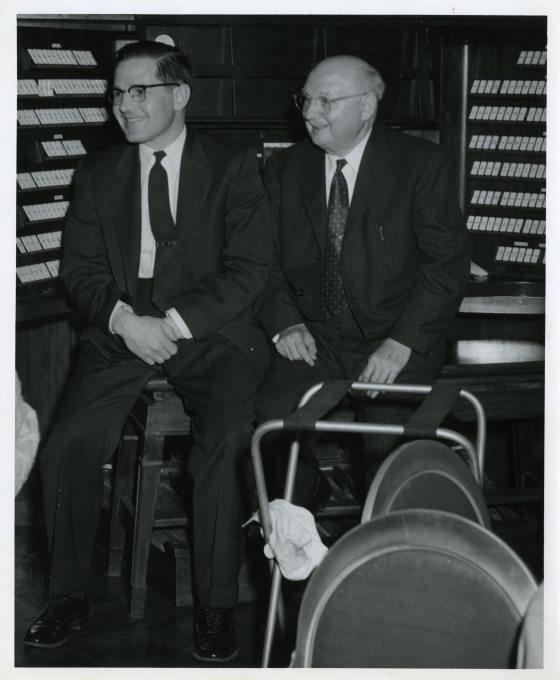
Clarence Snyder (left) with Firmin Swinnen at the latter’s retirement dinner, 1956. Photo by Gottlieb Hampfler.
The most unusual revelation is a reconstruction of the Longwood Color Organ, the brainchild of Mary Hallock Greenewalt and one of the most curious and humorous chapters in Longwood history. It was exhibited publicly only once, in January 1926, but it caused Pierre a mountain of headaches over the years.
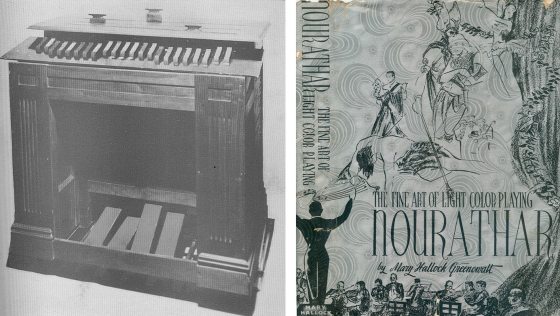
The console of the Color Organ (left photo) and the dust jacket of an accompanying book (right photo).
Some 175 color photos document performing arts in the Gardens from the mid-1950s to the present. In all the book has more than 900 photos and illustrations on 320 pages.

The Philadelphia Orchestra in 2011 (left photo); Bollywood Boulevard in 2018 (right photo). Left photo by Larry Albee; right photo by Colvin Randall.
The ultimate satisfaction of seeing the book in print is knowing that so much evanescent information has been preserved and made public, including the memories of participants who have passed on. So many of today’s world events are captured electronically and distributed via social media, but reconstructing the world of Pierre and Alice du Pont has taken a different type of detective work—and I’m thrilled to share the result of those 50 years of detective work with you.
